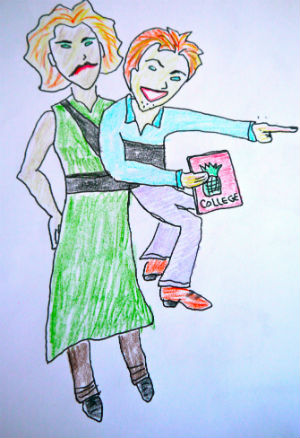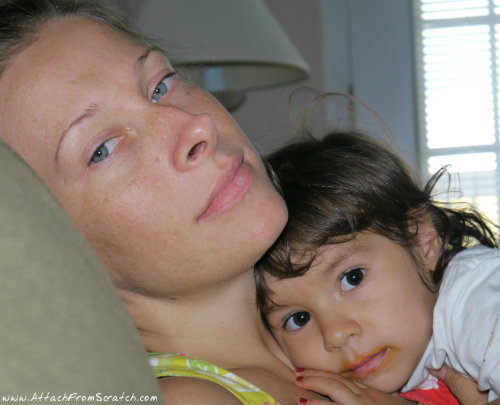Expressing Breast Milk
Your Way
Expressing breast milk? Honestly, I never thought about it until I had to do it.
"If breastfeeding is natural, expressing your breast milk should be pretty simple too", I said to myself.
Well, it actually can be pretty easy if you follow some guidelines and tips for better success.
In this article:
- Before you start pumping...
- How do you express breast milk?
- Expressing breast milk by hand
- Pumping with manual breast pumps
- Pumping with electric breast pumps
- Storing breast milk
Before you start pumping...
Before you decide to express/pump and bottle feed your baby, please keep in mind:
- Many studies have shown that breastfeeding your child fulfills your baby’s emotional and nutritional needs. No other feeding method can do that.
- Breastfeeding is not only about providing a baby with the breast milk. Big part of nursing is mother-child bonding, creating that infant secure attachment.
- Breastfeeding helps me a lot when I want to calm down my toddler.
However, many mothers think that expressing breast milk must be a part of breastfeeding.
Well, it is not. You don’t have to express/pump your breast milk, unless you fall under these special circumstances:
- your premature newborn is not able to nurse from breast yet
- your baby cannot latch properly to breastfeed
- you have some medical issues that does not allow you to nurse
- you have to go back to work/school
- you have to go away, where bringing baby with you is IMPOSSIBLE (keep in mind that breastfeeding in public is LEGAL, so consider bringing your baby to any social events you desire).
In the times when you have to bottle feed:
Try to mimic breastfeeding behaviors:
- Hold the baby as if you would be breastfeeding. Check for some breastfeeding positions here.
- Always keep eye contact and talk with your baby
- Make sure to feed on demand, not on schedules
- Change feeding positions
- Try always feeding baby yourself
- Always hold the baby and give him full attention when bottle feeding or when baby is using pacifier
- You should wean from the bottle the same you would from the breastfeeding - gradually and listening to baby’s cues.
How do you express
Breast Milk?
There 3 ways to do so:
1. Expressing breast milk by hand
2. Pumping breast milk with manual breast pump
3. Pumping breast milk with electric breast pump
Before pumping or expressing breast milk by hand use these tips for better success:
1. Wash your hands.
2. Drink plenty of water and have some of it near your when you express.
3. Massage your breast with your fingertips circling around on the breast tissue. Start from the armpit and work your way to the aureola area. Finish with the long strokes across the breast. Do so on both breasts.
If I was pumping because I was engorged, a warm shower always helped me to start a nice flow of my milk. Even a massage is not needed then. Milk starts pouring.
If you are at work, try putting a warm wet cloth on your breast.
4. Think about your baby or look at his picture if he is not near you.
5. Try to relax and be stress free. Find a calm and quiet place to pump. Make sure you feel safe and comfortable.
6. Try pumping as much as you can. As often as you would nurse. Or at least 3-4 times a day.
7. Always pump or express AFTER the breastfeeding (if you are breastfeeding).
8. You should express your breast milk in any clean container with a wide opening.
9. Consider these breast milk storage container tips.
Expressing breast
milk by hand
So how would you express milk if you don’t use breast pump?
Simply, by hand.
Did you know that you don’t need an expensive breast pump to express your milk. For many years women have been doing it without them and they were fine. Yes, the pumps might save you some time, but it does add some frustration, aggravation and stress which is not good for a nursing mother.
I think every mother should learn how to express breast milk by hand. You might need to do it in extra situations where fancy electric breast pumps might not be available.
While this doesn’t sound very complicated, my tips might save you some time and maybe even sore nipples.
Use these tips when expressing breast milk by hand:
I adjusted the Marmet Technique to my likings to express breast milk by hand.
1. Place your thumb little above the nipple, position other 2 fingers below the nipple (about 1.5” away from the nipple). Make sure all 3 fingers are in the same vertical line forming letter “C” with your hand.
2. Press. Keep your fingers in the same position.
3. Roll your fingers towards the nipple as you squeeze the breast.
The trick is to put pressure on the milk ducts behind your nipple, rather than squeezing the nipple itself.
Repeat this action until breast milk doesn’t come out or very little comes out.
POSITION -> PRESS -> ROLL
Do not do this while expressing breast milk:
1. Do not squeeze the breast, because it can bruise and irritate the breast.
2. Do not slide with your hand over the breast, because it can actually cause skin burns.
3. Do not pull the nipple, because it can damage breast tissue.
Kellymom.com uses this information to estimate the average amount of milk baby will need at a feeding:
- Estimate the number of times that baby nurses per day (24 hours).
- Then divide 25 oz by the number of nursings.
- This gives you a “ballpark” figure for the amount of expressed milk your exclusively breastfed baby will need at one feeding.
How fast and how much can I express by hand?
With some practice and determination you will be a pro in expressing breast milk by hand.
Actually I was able to express more breast milk by hand then by a manual breast pump.
Every women is different. It depends on how is your milk flow. For example, I have been lucky, because when I express by hand my milk “shoots” across the room on the wall and I can fill 4-6 ounces in 15 minutes.
Watch this video to visualize better the expressing breast milk by hand
Pumping with
manual breast pump
Manual breast pumps are great because:
- they are cheap
- they are easier to assemble
- they are easier to wash
- easier to take it with you
- allows you to control the pressure and the frequency of milk expression
Personally, manual breast pumps scare me less, because it doesn’t look so heavy machinery as an electric pump.
The down side:
- it requires you to use at least one of your hands to pump
- it might take longer to pump with the manual pump.
- if pumping a lot, you might get tired, because you use your hand to pump.
Manual breast pumps are perfect:
- if you are using pumping on rare occasions
- if you need to pump just a little of breast milk
- if you travel and electric pump is not an option
How to use manual breast pump:
1. Assemble the pump according to the instructions.
2. Place your nipple as deep as possible into the shield. Make sure nipple is in the center of the shield and it feels comfortable to you.
3. When manually pumping, try mimicking the baby’s sucking rhythm. 2-3 pumps and a pause. And again, 2-3 pumps - pause.
4. Don’t be alarmed if the milk won’t come for first few minutes.
How long should I pump with manual breast pump?
Normally 15-30 on each breast, but every woman's milk flow is different, so as long as you see milk is coming keep on going.
How much of breast milk should I express during 1 session?
Again,
as every women is different, there is not 1 answer. However, even if 30
minutes of active manual pumping produced only few ounces of milk,
don’t be frustrated because that stress might be one of the reasons your
let-down is low. Try using tips above to increase the let-down and get
more milk. And keep in mind that every drop of breast milk counts.
Pumping with
electric breast pumps
If you are a working mother, expressing breast milk with electric pump might the best option for you.
There are few kinds of electric breast pumps:
1. Large electric pumps(or "hospital-grade"). These are very heavy, big and of course very expensive. But they are perfect for establishing some breast milk. You can usually rent these pumps from hospitals.
2. Regular consumer electric breast pumps. These pumps are perfect for working mothers since they come in a descret black bags and they are not as big and heavy. Their cost is lower too ($200-$300).
3. Small electric or battery breast pumps. They are cheaper (about $50). These pumps are only good if you need to pump once in a while.
Keep in mind that the motor of electric breast pumps lose some of its power after about 1 year.
Storing Beast Milk
OK. So you’ve got your milk. What’s next?
There is no good use of breast milk if you don’t freeze it proper.
When storing breast milk in containers keep in mind:
- check for breast milk storage containers without BPA (chemical bisphenol)
- glass or plastic containers (hard-sided) with the tight-fitting tops.
- freezer bags specially designed to store human milk.
- containers that are not filled up to the top. Make sure to leave 1” till the top, because breast milk expands when it freezes.
- it is washed in hot, soapy water and air-dried properly.
- consider putting 2-4 oz of breast milk not to waste it.
- always mark the date and the name of your baby (if he is fed in daycare) on the storage containers.
- make sure to always use to oldest breast milk.
There is a big
variety of breast milk storage in the market. You can store breast milk
in milk storage bags, milk storage plastic bottles, glass bottles,
plastic cups with tight lids, there are special trays to put in the
freezer. Anything to keep that breast milk as good as we can.
Read this article for more information about breast milk storage.
TO conclude:
If you are having breastfeeding problems use rental pumps
If you are working use rental or large double electric pump
If you are pumping occasionally use small electric or manual pump
HOWEVER, try expressing breast milk by hand before you decide on using any breast pumps.
You might also like:
What is Attachment Parenting (AP)?
|
Like This Page?
|
|
Let Google know about it |










